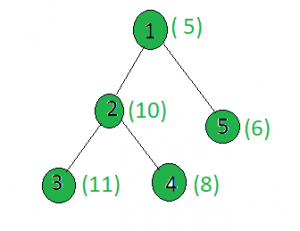给定一棵树和所有节点的权重,任务是计算权重为偶校验的节点的数量,即它们中设置位的计数是否为偶数。
例子:
Input:

Output: 3
| Weight | Binary Representation | Parity |
|---|---|---|
| 5 | 0101 | Even |
| 10 | 1010 | Even |
| 11 | 1011 | Odd |
| 8 | 1000 | Odd |
| 6 | 0110 | Even |
方法:在树上执行 dfs,对于每个节点,检查它的权重是否为偶校验。如果是,则增加计数。
下面是上述方法的实现:
C++
// C++ implementation of the approach
#include
using namespace std;
int ans = 0;
vector graph[100];
vector weight(100);
// Function that returns true if count
// of set bits in x is even
bool isEvenParity(int x)
{
// parity will store the
// count of set bits
int parity = 0;
while (x != 0) {
x = x & (x - 1);
parity++;
}
if (parity % 2 == 0)
return true;
else
return false;
}
// Function to perform dfs
void dfs(int node, int parent)
{
// If weight of the current
// node has even parity
if (isEvenParity(weight[node]))
ans += 1;
for (int to : graph[node]) {
if (to == parent)
continue;
dfs(to, node);
}
}
// Driver code
int main()
{
// Weights of the node
weight[1] = 5;
weight[2] = 10;
weight[3] = 11;
weight[4] = 8;
weight[5] = 6;
// Edges of the tree
graph[1].push_back(2);
graph[2].push_back(3);
graph[2].push_back(4);
graph[1].push_back(5);
dfs(1, 1);
cout << ans;
return 0;
} Java
// Java implementation of the approach
import java.util.*;
class GFG
{
static int ans = 0;
static Vector> graph = new Vector>();
static Vector weight = new Vector();
// Function that returns true if count
// of set bits in x is even
static boolean isEvenParity(int x)
{
// parity will store the
// count of set bits
int parity = 0;
while (x != 0)
{
x = x & (x - 1);
parity++;
}
if (parity % 2 == 0)
return true;
else
return false;
}
// Function to perform dfs
static void dfs(int node, int parent)
{
// If weight of the current
// node has even parity
if (isEvenParity(weight.get(node) ))
ans += 1;
for (int i = 0; i < graph.get(node).size(); i++)
{
if (graph.get(node).get(i) == parent)
continue;
dfs(graph.get(node).get(i) , node);
}
}
// Driver code
public static void main(String args[])
{
// Weights of the node
weight.add( 0);
weight.add( 5);
weight.add( 10);;
weight.add( 11);;
weight.add( 8);
weight.add( 6);
for(int i=0;i<100;i++)
graph.add(new Vector());
// Edges of the tree
graph.get(1).add(2);
graph.get(2).add(3);
graph.get(2).add(4);
graph.get(1).add(5);
dfs(1, 1);
System.out.println( ans );
}
}
// This code is contributed by Arnab Kundu Python3
# Python3 implementation of the approach
ans = 0
graph = [[] for i in range(100)]
weight = [0]*100
# Function that returns True if count
# of set bits in x is even
def isEvenParity(x):
# parity will store the
# count of set bits
parity = 0
while (x != 0):
x = x & (x - 1)
parity += 1
if (parity % 2 == 0):
return True
else:
return False
# Function to perform dfs
def dfs(node, parent):
global ans
# If weight of the current
# node has even parity
if (isEvenParity(weight[node])):
ans += 1
for to in graph[node]:
if (to == parent):
continue
dfs(to, node)
# Driver code
# Weights of the node
weight[1] = 5
weight[2] = 10
weight[3] = 11
weight[4] = 8
weight[5] = 6
# Edges of the tree
graph[1].append(2)
graph[2].append(3)
graph[2].append(4)
graph[1].append(5)
dfs(1, 1)
print(ans)
# This code is contributed by SHUBHAMSINGH10C#
// C# implementation of the approach
using System;
using System.Collections.Generic;
class GFG
{
static int ans = 0;
static List> graph = new List>();
static List weight = new List();
// Function that returns true if count
// of set bits in x is even
static bool isEvenParity(int x)
{
// parity will store the
// count of set bits
int parity = 0;
while (x != 0)
{
x = x & (x - 1);
parity++;
}
if (parity % 2 == 0)
return true;
else
return false;
}
// Function to perform dfs
static void dfs(int node, int parent)
{
// If weight of the current
// node has even parity
if (isEvenParity(weight[node]))
ans += 1;
for (int i = 0; i < graph[node].Count; i++)
{
if (graph[node][i] == parent)
continue;
dfs(graph[node][i] , node);
}
}
// Driver code
static void Main()
{
// Weights of the node
weight.Add(0);
weight.Add(5);
weight.Add(10);
weight.Add(11);
weight.Add(8);
weight.Add(6);
for(int i = 0; i < 100; i++)
graph.Add(new List());
// Edges of the tree
graph[1].Add(2);
graph[2].Add(3);
graph[2].Add(4);
graph[1].Add(5);
dfs(1, 1);
Console.WriteLine( ans );
}
}
// This code is contributed by mits Javascript
输出:
3复杂度分析:
- 时间复杂度: O(N)。
在 DFS 中,树的每个节点都被处理一次,因此对于树中的 N 个节点,由于 DFS 的复杂性是 O(N)。因此,时间复杂度为 O(N)。 - 辅助空间: O(1)。
不需要任何额外的空间,因此空间复杂度是恒定的。
如果您希望与专家一起参加现场课程,请参阅DSA 现场工作专业课程和学生竞争性编程现场课程。